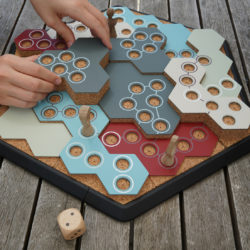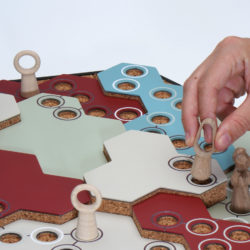Warum zitterst Du?
Description
"Why are you trembling?" is a practical elaboration in the form of a board game, based on theoretical knowledge, which is designed to promote motor skills in children and adults with Parkinson´s disease. With a supplementary information book, Parkinson's disease is explained in a child-friendly manner using simple words and illustrations.What is the Topic?
Parkinson's disease is the second most common neurological disease worldwide after Alzheimer's. It affects about 400,000 patients in Germany merely, even 6 million people globally are affected. A cure does not seem to be in sight. The first symptoms usually appear between the ages of 50 and 60, but there are also people who get Parkinson at a much younger age. The symptoms of an ill family member usually affects the whole family and turns everyone's everyday life upside down. But how do you explain to your (grand)children that you are ill, and how do you overcome fear of contact with the illness? This is the basis for my two products, which are designed to make sure that Parkinson's symptoms and the course of the disease are explained in a pedagogically valuable way, especially to children. In addition, the motor skills and communication are supported by a board game and a small information book.
Why does it look like this?
The design was influenced by various parameters, which was the result from previous detailed analyses. The concept is based on the classic game "ludo", which had the potential to be redesigned for Parkinson's patients because of the small elements. The course of the game was subsequently extended by activities that promote fine motor skills. The focus was to create a design with the right colour, shape and materials for young and old people and to train the motor skills - but in such a way that certain movement exercises were hardly noticed and not perceived as a burden. The basic form of the board game is formed by a large honeycomb shape, which contains small, grouped honeycomb modules of different sizes. The different heights of scaling are intended to contribute to a three-dimensionality, which at the same time ensures that the individual parts can be experienced haptically. In this way, the individual parts of the game can be easily used by the two-point or clamp grasp which can be used in occupational therapy. The basic surface of the game is divided in four parts and slightly suggests the shapes of the modules to make puzzling easier and to start really quick. The raised edge of the base surface holds the individual board game pieces together while playing. The puzzle game promotes the fine motor skills and the communication between the players (in the sense of "Which piece belongs where?"). All game components are scaled larger to be gripped easier. Some of the components have integrated magnets so nothing can topple over on the board. It prevents the feeling of failure.
What is special?
The concept of traditional supportive aid-tools is taken up, but looks in more detail at the actual target group. My work is designed for a large target group between the ages of 6 and 80. The target group contains children who are indirectly confronted with (grand-)parents suffering from Parkinson's disease, and Parkinson's patients themselves, who can be affected at a young age or either become ill at an older age. Previous supportive aid-tools sometimes create emotional barriers. Those affected feel disparaged and left out. The helping tools on the market are designed really badly that most of the people don’t like to show it in public. Fears in relation to the illness are always projected onto the outside world. In many families it is not sufficiently disclosed what Parkinson's disease effect on all areas of life. With the help of the information book and the accompanying board game, communication barriers are broken down and it helps in a playful way how to deal with the situation. The game is not about winning, in the foreground is fun and the execution or the exercises for motor skills. In addition, the game can be adapted to the respective daily condition of the patient. The modular parts of the game, give the possibility to play a slightly longer variant, which is accompanied by movement exercises, or the simpler, faster variant. To make this possible, the modules sitting in the middle can be turned around depending on how the patient feels.
What is new?
"Why are you trembling?" is a tool for people with Parkinson's without being an obvious tool. Playfully, the attributes of the disease are explained and fears are gradually taken away. During the reading out process the little book brings people closer together, besides it can clarify open questions and helps with general understanding. The game ensures open communication and small motor exercises for all participants. In this way, sick people do not feel treated as separate entities and it is possible to continue an almost normal everyday life.




